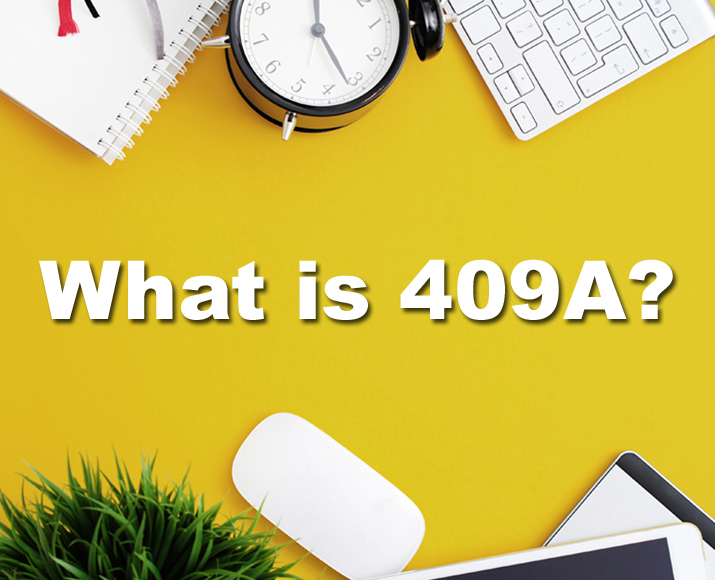IRC 409A OVERVIEW
10 December 2020

Introduction to IRC 409a
The Section 409A regulation of the United States Internal Revenue Code mandates that a privately held company cannot issue stock options to employees below the Fair Market Value. Stock options or Equity-based compensation needs to be issued at or above fair value in order to avoid significant tax penalties, including federal and varying state tax penalties. Furthermore, such Fair Market Value should ideally be determined by an independent third party Appraiser in order to qualify for safe harbor under IRC Section 409A.
Requirement of 409a Valuation
A 409A valuation is not equivalent to what an investor may decide your company is worth, nor is it a great sales tool for potential investors. A 409A valuation provides a company with the fair market value of common stock. This valuation will allow you to issue equity-based compensation to employees at fair market value, including stock options, restricted shares, and other share-based equity instruments. A new 409A valuation must be performed whenever there is a material corporate event including, but not limited to:
- Issuing ESOPs for the first time
- After raising a round of venture financing or qualified financing
- Any significant change to business operations or plans
- If an entity approaching an IPO
- Any other material events including acquisitions, divestitures, secondary sales of common stock, business model pivots, and missing or exceeding financial projections.
A 409A valuation is presumed reasonable and valid if the stock was valued within 12 months of the applicable option grant date and no material change has occurred between the valuation date and the grant date. Hence, in case if none of the material events happened within the privately held company and the previous 409A valuation is over one year old, the company will require a fresh 409a valuation to avoid tax penalties.
Acceptable Methodologies for 409a Valuation
Choosing an appropriate valuation methodology or multiple approaches is dependent on multiple factors which cannot be predefined on certain parameters. However, there are certain factors which influence methodology selection include the Stage of the Company as of valuation date, Company's recent funding history, timing to a liquidity event etc. The Valuation methodologies accepted by the AICPA Practice Aid includes:
- Subject Company Transaction Method: The Subject Company Transaction Method (Backsolve) within the Market approach is professionally recognized as a best practice and recommended in the new AICPA guidelines for valuation of equity compensation in privately owned companies. This method is applicable only when the subject company has sold shares in a recent, arm's length transaction or equity round of financing.
- Guideline Publicly Traded Company Method: The Guideline (or Comparable) Publicly Traded Company Methodology within the Market Approach relies on an analysis of publicly traded companies similar in industry and/or business model to the subject Company. This methodology uses the guideline companies to develop relevant market multiples and ratios, using metrics such as revenue, earnings before interest and taxes (EBIT), earnings before interest, taxes, depreciation and amortization (EBITDA), net income and/or tangible book value. These multiples and values are then applied to the Company’s corresponding financial metrics. This methodology is not suitable for early stage growth companies.
- Guideline M&A Transaction Method: The Guideline M&A Transaction Methodology within the Market Approach uses actual prices paid in merger and acquisition transactions for companies similar to the Company. Exit multiples of total purchase price paid to revenues, EBIT, EBITDA, net income and/or book value may be developed for each comparable transaction, if the data is available. These multiples are then applied to the Company’s corresponding latest 12-month and projected financial metrics whichever suitable.
- Income Approach: The income approaches determine fair market value by dividing the benefit stream generated by the subject or target company by a discount or capitalization rate. The discount or capitalization rate converts the stream of benefits into present value. The income approach focuses on the income producing capability of the company.
- Asset Approach: This method determines the worth of a business by the assets it possesses. This approach considers reproduction or replacement cost as an indicator of value. This approach assumes that a prudent investor wouldn’t pay more for any entity than the amount that he or she could use to replace or re-create it. Valuation professionals use historical costs to estimate the current cost of replacing the entity valued.
Conclusion
The pandemic COVID-19 outbreak and subsequent lockdown had severally affected global economies which has resulted in business disruption, volatility and significant fall in revenue of the companies worldwide. The COVID-19 pandemic and recent market changes may be considered as a material event and result in changes to company's 409A valuation. In order to calculate the magnitude of any value changes, the Valuer will need to understand the impact in business and any changes in forecasts. An improper valuation can lead to numerous unintended consequences, including major tax penalties for employees and the Company.
At Proxcel, we provide audit-defensible 409A valuations. Our team have experience Valuers who have successfully completed thousands of 409A valuations for high-growth companies ranging from startups to unicorns. This deep experience helps us dial-in on the factors that are critical to your company.

